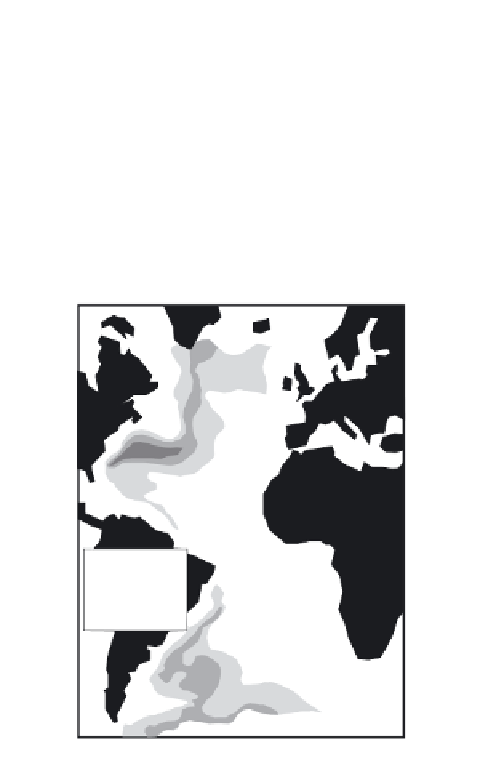Geoscience Reference
In-Depth Information
Spain
Gibralter
gateway
Mediterranean
Atlantic
Morocco
Fig. 6.31
Deep outflow of dense Mediterranean water through the Gibralter gateway.
sinking waters of the polar oceans (Fig. 6.30). The nature
of the oceanic circulation, with its links from surface to
depth, and its role in heat transport and redistribution, has
led to its description as a
global conveyor belt
of both heat
and kinetic energy. The consequences of this deep circula-
tion are profound, since steady current velocities of up to
0.25 m s
1
have been recorded in some areas where the
normally slow (
c
.0.05 m s
1
) thermohaline currents are
accelerated on the western sides of oceans (for the same
vorticity reasons as discussed earlier for surface currents)
and in
topographic constrictions
like gaps between mid-
ocean ridges, oceanic fracture zones, and oceanic island
chains and plateaux margins. In all these case
turbulent
mixing
is accentuated due to the rough topography, a phe-
nomenon that occurs at all scales from laboratory flows
(Section 4.5) to the oceans.
Dense water masses from the Antarctic and Arctic seas
sink to become the Antarctic Bottom Water (ABW) and
North Atlantic Deep Water (NADW); total discharge in
the range of 10-40 Sv respectively. ABW forms the majority
of the bottom flow around the Antarctic as a circum-
polar current, receiving NADW from the western South
Atlantic in a series of huge migrating warm-core eddies
and in turn leaking large discharges northward from the
Weddell sea and other sources into the South Atlantic
(under and alongside the NADW), Indian and Pacific
Oceans. Intra-ocean transfers occur in the winter as evap-
orative fluxes from the Mediterranean to the Atlantic and
from the Red Sea/Arabian Gulf to the Indian Ocean. The
Mediterranean example is a classic case of flow forced to
intensify through the narrow constriction at the Straits of
Gibralter (Fig. 6.31), at velocities that exceed 3 m s
1
,
then decelerating out into the Gulf of Cadiz, but is still as
60
45
30
15
>2,000
0
500-2,000
1-500
15
<100
mg cm
3
30
45
60
30
0
30
Fig. 6.32
The Atlantic nepheloid layer.
high as 0.2 m s
1
at Cape St Vincent. The Mediterranean
Outflow Water (MOW) is warm (13
C) and saline
(
37 g l
1
) and spreads out to mid-depth (800-1200 m)
in the North Atlantic. The MOW is compensated by an
inflow of Atlantic water: the combined circulations being
described as
anti-estuarine
, that is, salty dense water out
and fresher less-dense water in.
Recent results also confirm earlier observations that
there is significant flux of deepwater through fracture
zones across and along mid-ocean ridges. Thus transfer
of ABW from the western to the eastern side of the
South Atlantic occurs through the larger silled fracture



















Search WWH ::

Custom Search